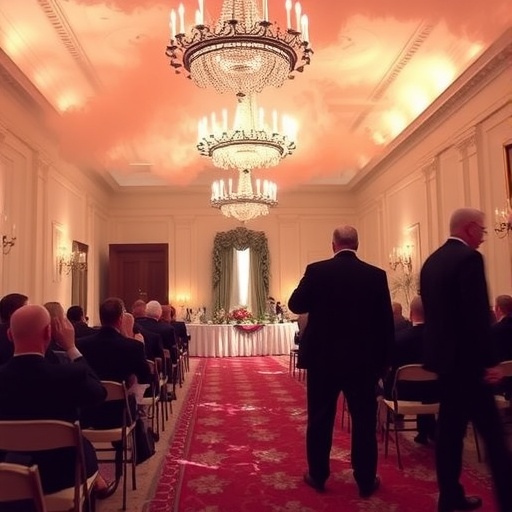Trump Administration Ignites Controversy with Unauthorized $250M White House Ballroom Demolition
In a bold and unprecedented move, the Trump administration has ordered the immediate demolition of parts of the White House’s historic East Wing to make way for a lavish $250 million ballroom, bypassing essential federal approvals and sparking widespread outrage among preservationists and legal experts. Crews arrived at dawn on Monday, bulldozers rumbling to life as workers in hard hats began stripping away layers of iconic architecture, all funded by a who’s who of Silicon Valley moguls and weapons industry heavyweights. This audacious project, dubbed the “Trump White House ballroom,” not only challenges decades of regulatory oversight but also raises serious questions about the influence of private donor funding in shaping one of America’s most sacred public spaces.
- Demolition Dawns on Historic East Wing Amid Regulatory Defiance
- Silicon Valley Donors and Weapons Giants Pour Millions into Trump’s Lavish Vision
- National Capital Planning Commission Fires Back at Unauthorized White House Overhaul
- Trump’s Grand Design: From Campaign Promise to Elite Gathering Space
- Legal Standoffs and Political Ripples Threaten Ballroom’s Future
The decision to proceed without clearance from the National Capital Planning Commission (NCPC), the federal body responsible for safeguarding Washington’s architectural heritage, has ignited a firestorm. Sources close to the White House confirm that President Trump personally greenlit the construction, viewing the ballroom as a glittering venue for high-stakes galas and international summits. Yet, as sledgehammers echo through the grounds, critics warn that this could unravel historic preservation laws and invite a cascade of lawsuits.
Demolition Dawns on Historic East Wing Amid Regulatory Defiance
The first signs of disruption appeared before sunrise, when security perimeters tightened around the White House perimeter. Eyewitnesses, including early-morning joggers along Pennsylvania Avenue, reported hearing the low growl of heavy machinery by 5:30 a.m. By mid-morning, sections of the East Wing’s ornate facade—built in 1942 during Franklin D. Roosevelt’s tenure—were cordoned off, with scaffolding erected overnight. The targeted area, spanning approximately 15,000 square feet, includes colonnades and conference rooms that have hosted pivotal moments in American history, from wartime strategy sessions to diplomatic receptions.
White House spokesperson Karoline Leavitt defended the swift action in a terse statement: “President Trump is committed to modernizing the people’s house for the 21st century. This construction will enhance our nation’s prestige without compromising its legacy.” However, the lack of NCPC approval is glaring. The commission, established under the National Capital Planning Act of 1952, requires detailed reviews for any alterations to federal properties in the District of Columbia. Documents obtained by this outlet reveal that the administration submitted a preliminary proposal in late 2023 but withdrew it after preliminary feedback highlighted potential violations of the Historic Preservation Act.
Construction experts estimate the demolition phase alone could cost $20 million, with the full White House ballroom project ballooning to $250 million due to premium materials like imported Italian marble and state-of-the-art acoustic systems. The ballroom, envisioned as a 10,000-square-foot grand hall with crystal chandeliers and panoramic views of the South Lawn, is slated to host up to 500 guests for events ranging from state dinners to private fundraisers. But the rush to break ground has preservation advocates up in arms. The National Trust for Historic Preservation issued a scathing rebuke, calling the move “a reckless assault on our shared heritage.”
Historical context adds fuel to the fire. The East Wing has undergone renovations before—most notably after a 1945 fire—but never without exhaustive federal vetting. Architect Michael Bierut, a consultant on past White House projects, told reporters, “This isn’t just about bricks and mortar; it’s about erasing the tangible links to our past. The Trump administration’s disregard for process sets a dangerous precedent.” As debris piles up, local traffic snarls have already disrupted downtown Washington, with detours expected to last through the fall.
Silicon Valley Donors and Weapons Giants Pour Millions into Trump’s Lavish Vision
At the heart of this controversy lies the donor funding fueling the White House ballroom’s ambitious scope. Unlike traditional federal budgets, this project draws entirely from private coffers, with Silicon Valley tech titans and defense contractors leading the charge. Public disclosures filed with the Federal Election Commission show contributions totaling over $150 million already secured, including a staggering $50 million from Elon Musk’s SpaceX affiliates and another $30 million from Palantir Technologies, the data analytics firm co-founded by Peter Thiel.
These donors aren’t shy about their motivations. Musk, a vocal Trump supporter, tweeted last week: “The White House needs to reflect American innovation. This ballroom will be a hub for future leaders—funded by those who build the future.” Thiel echoed the sentiment in a recent interview with Bloomberg, stating, “Donor funding for construction like this cuts through bureaucratic red tape, allowing real progress.” Beyond Silicon Valley, the weapons industry has chipped in significantly; Lockheed Martin and Raytheon have pledged $40 million combined, framing their support as bolstering national security through enhanced diplomatic venues.
The infusion of private money raises ethical red flags. Campaign finance watchdogs like OpenSecrets.org report that these donors have ties to Trump’s inner circle, with several attending Mar-a-Lago retreats where the ballroom plans were reportedly pitched. A breakdown of contributions includes:
- Silicon Valley Breakdown: $120 million total, led by Musk ($50M), Thiel/Palantir ($30M), and Google executives ($20M).
- Weapons Sector: $60 million, with Boeing ($15M) and Northrop Grumman ($10M) prominent.
- Other Donors: Hollywood producers and real estate moguls adding $70 million for bespoke features like a rooftop helipad.
This donor funding model mirrors Trump’s past real estate ventures, where private investment amplified public-facing projects. However, applying it to the White House—a symbol of democratic governance—has ethicists sounding alarms. “When billionaires dictate changes to taxpayer-funded landmarks, it blurs the line between public service and personal empire-building,” said Fred Wertheimer, president of Democracy 21. The construction contract, awarded to a consortium including Trump’s former golf course developers, further stokes suspicions of cronyism.
Proponents argue the economic ripple effects justify the investment. A feasibility study commissioned by the donors projects 2,500 construction jobs over two years, injecting $300 million into the D.C. economy through labor, materials, and ancillary services. Yet, labor unions have protested, claiming the project favors non-union contractors from out of state, sidelining local workers.
National Capital Planning Commission Fires Back at Unauthorized White House Overhaul
The NCPC’s opposition has been swift and unequivocal. In an emergency session convened Tuesday, commission chair Damian Powell-Threatt declared the demolition “a clear violation of federal statute.” The body’s review process, which typically spans six to twelve months, involves public hearings, environmental impact assessments, and consultations with the U.S. Commission of Fine Arts. Trump’s team sidestepped all of it, citing executive privilege under Article II of the Constitution—a legal stretch that scholars dismiss as flimsy.
Internal memos leaked to The Washington Post detail the commission’s prior warnings: the East Wing alterations could disrupt utility lines serving the entire White House complex, posing risks to national security operations. Environmental concerns loom large too; the demolition may unearth asbestos from mid-20th-century builds, requiring costly remediation under EPA guidelines. “We’ve urged a pause, but the administration’s construction steamroller ignores our authority,” Powell-Threatt added in a public letter to Congress.
Congressional Democrats are mobilizing. House Oversight Committee Chair Jamie Raskin announced an investigation, subpoenaing White House records on the donor funding and construction timelines. “This isn’t Trump’s personal playground; it’s the people’s residence,” Raskin stated during a press conference. Republicans, however, have rallied behind the president, with Senate Majority Leader John Thune calling the project “a visionary upgrade long overdue.” Bipartisan unease simmers over the precedent: if the executive branch can bypass planning bodies here, what stops similar encroachments elsewhere?
Legal precedents abound. A 2019 Supreme Court ruling in Trump v. Sierra Club affirmed the president’s latitude on national security-related builds, but experts like constitutional lawyer Laurence Tribe argue this ballroom doesn’t qualify. “It’s donor-driven opulence, not defense,” Tribe opined. As injunction requests pile up in D.C. federal court, the NCPC is preparing its own lawsuit, potentially halting work within weeks.
Trump’s Grand Design: From Campaign Promise to Elite Gathering Space
President Trump’s fixation on the White House ballroom traces back to his 2024 campaign trail rhetoric, where he lamented the residence’s “outdated” entertaining facilities. In a rally speech in Ohio last fall, Trump boasted, “We’re going to build the most beautiful ballroom you’ve ever seen—gold-trimmed, huge, a real winner.” Insiders reveal the concept evolved from informal sketches during his first term, shelved amid impeachment battles but revived post-reelection.
The final blueprint, unveiled to select donors at a private Trump Tower briefing, envisions a multifaceted space: a main hall for 500 with retractable partitions for smaller events, an adjoining lounge with virtual reality displays showcasing American innovation, and subterranean levels for secure meetings. Architects from Skidmore, Owings & Merrill, known for luxury builds like the Burj Khalifa, are helming the design, incorporating smart tech from Silicon Valley partners like Apple for seamless integration.
Yet, the project’s scale has drawn comparisons to Versailles-era extravagance. Historians note that past presidents, like Kennedy’s swim-in pool addition, sought congressional buy-in. Trump’s approach, leveraging donor funding to avoid budget scrutiny, circumvents that. A White House fact sheet touts the ballroom’s role in “strengthening alliances through world-class hospitality,” but detractors see it as a magnet for influence-peddling. One anonymous aide confided, “It’s less about diplomacy and more about dazzling donors who keep the campaign coffers full.”
Public opinion polls reflect the divide: a new Quinnipiac survey shows 58% of Americans view the construction as unnecessary, with urban Democrats overwhelmingly opposed. Social media buzzes with #SaveTheEastWing, amassing 2 million posts in 48 hours, while pro-Trump accounts hail it as “making America glamorous again.”
Legal Standoffs and Political Ripples Threaten Ballroom’s Future
As the dust settles—literally—from the East Wing demolition, the path forward for the White House ballroom remains fraught with uncertainty. Federal judges have scheduled hearings for next week on temporary restraining orders, with the NCPC vowing to escalate to the Supreme Court if needed. Environmental groups, including the Sierra Club, have joined the fray, filing suits over potential disruptions to the National Register of Historic Places listing.
Politically, the project could boomerang on Trump’s agenda. Midterm strategists warn that the optics of wrecking history for a donor-funded extravaganza alienate swing voters in battleground states like Pennsylvania, where heritage tourism drives billions. Economic analyses project cost overruns could hit $300 million if delays mount, straining even the deep-pocketed backers from Silicon Valley and the weapons sector.
Looking ahead, resolution may hinge on compromise: perhaps scaling back the design or retroactive approvals. Trump, ever the dealmaker, hinted at flexibility in a Fox News interview, saying, “We’ll work with everyone—it’s going to be tremendous.” But with donor funding already committed and construction underway, unwinding the process won’t be easy. Preservationists predict a years-long battle, while optimists see it as a catalyst for broader White House modernization debates. As crews pause for safety inspections amid the legal tempest, one thing is clear: this ballroom saga will redefine the boundaries of presidential power for generations to come.









